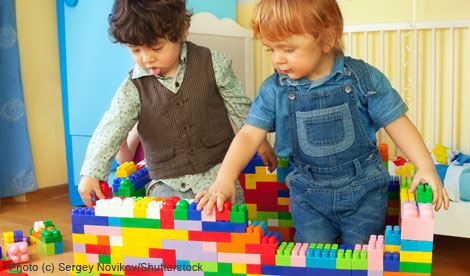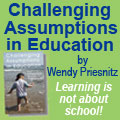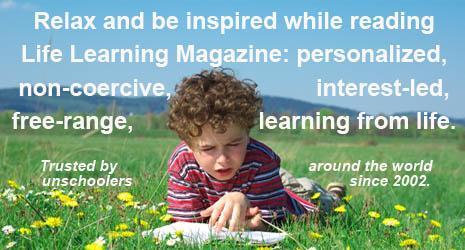|

Parenting With Abundance, Not Scarcity
By Lori Pickert
Recently, on my blog, I shared how we use generous limits as a way of dealing with screen time and how that approach reflects an abundance versus scarcity mindset.
When I owned a small Reggio-inspired school and worked as an educational consultant, I often ran into this type of problem, where emotions are high and adults and children are in opposition. No one is happy and the overarching goals are not being met.
Scarcity situation:
- Conflict arises because of a scarcity situation (or a perceived scarcity situation).
- There is intense focus around the item or experience that is felt to be scarce.
- The adult is frustrated by the child’s intense focus.
- The adult wants to “teach a lesson” through scarcity.
- Much time is spent arguing, bargaining, and complaining (the ABCs of scarcity).
Scarcity issues typically arise directly from how the adult has organized the situation. Once conflict occurs, the adult usually maintains the scarcity for a reason: because they want to teach a lesson.
Here’s a reenactment of a mentoring session I did with a preschool whose teachers had visited us. All names and details have been changed.
Sunnyside: We want our kids to be working on projects and collaborating like yours do, but all they do is fight all morning.
Me: What are they fighting about?
Sunnyside: Well, there are a lot of boys in this class and only four kids can use the block center at a time. They fight constantly about who is in the block center, whose turn it is, how long they’ve been in there, and so on. Then, even when they’re in the block center, we have two wooden trucks and they fight over who gets to use those.
Even the girls who weren’t even interested in blocks are demanding to play in the block center and demanding their turn with the trucks, just because they see the boys fighting about it. All we do all morning is referee arguments. No one is working on any projects. All they do is fight about this.
Me: What have you tried so far?
Sunnyside: We want the kids to use all the centers instead of just staying in one place all morning, so every half-hour we have them move from one center to the next one. And we have an egg timer to keep track of whose turn it is with the wooden trucks, but we get busy and sometimes we forget to check it, then they fight even more.
Me: Okay, you need to do two things.
Sunnyside: Tell us!
Me: You need to drop the limit on how many kids can be in the block center and you need to buy more wooden trucks.
Sunnyside: What?! But they won’t all fit into the block center! And giving them what they want seems totally wrong — shouldn’t they be learning how to share?
Me: Just try it, then get back to me in a week.
So here’s what happened:
When the strict limits were taken away, all the kids did try to crush into the block center at once. There was a lingering residue of “the block center is the desired place to be.” Sixteen kids pressed around one small table and a limited number of blocks didn’t work, and the kids figured that out on their own. It was boring to stand in a crowd with hardly any blocks to play with, so after awhile, some of the kids wandered away. The ones who stayed began to negotiate how they would share the blocks.
When the new wooden trucks arrived, the kids ceased arguing about them and started playing with them.
A week later:
Me: How’s it going?
Sunnyside: Much better. But we still have more kids who want to play in the block area than the block area will accommodate. They are crushed in there together and they’re doing pretty well, but there isn’t enough room.
Me: Make the block area bigger.
Sunnyside: Wha— [sigh] Okay.
When you have a scarcity situation, the first thing to look at is: What am I trying to accomplish by using scarcity?
These teachers had good goals for their students:
- They wanted them to use the whole classroom and not just one center.
- They wanted them to collaborate and not argue all the time.
- They wanted them to work on long-term projects. But their choices had made the exact opposite happen.
Instead of valuing all the areas of the classroom (art studio, library, science area, etc.), the kids were all hyper-focused on what they couldn’t have: the block center.
Instead of collaborating, they were arguing and bargaining and complaining all morning.
Instead of working on long-term projects, they were being rotated through the centers, so that even if they were involved in what they were doing, they were interrupted to move on in the name of variety. Whatever a child was building in the block area, someone else knocked down a half-hour later. Whatever a child was painting in the art studio, he had to drop it and leave — so why ever start anything complex or ambitious? Whatever book two children were looking at together they had to put back on the shelf and move on — so no deep interests ever sparked.
The teachers were accidentally training the kids not to focus, not to invest in big ideas, and not to work on long-term projects. They were accidentally training them to have the opposite traits than they wanted: developing short attention spans, seeing each other as competitors rather than collaborators, and so on.
The work of figuring out how to share can’t start until children are given the responsibility and freedom to do that work. When you create a scarcity situation, you aren’t teaching them how to share, you’re teaching them how to compete hard for what’s rightfully theirs. When they are given the tools, the opportunity, and the support, they can begin to build those character traits and habits of mind you want for them.
The work of figuring out how to self-regulate can’t happen until children have enough elbow room to make some of their own choices. You aren’t teaching kids how to restrict their own screen time when you restrict it for them. There is literally not enough white space for them to give them any control or decision-making, so they aren’t building any skills. They’re just reacting emotionally to a situation that you control. How can they learn to make good choices if they don’t get the opportunity to make bad ones?
With generous limits, children find that they have to make decisions: Do I finish drawing this comic, or play Minecraft? Now they’re beginning to make choices and deal with consequences. They may make what you think are wrong choices, but mistakes are the pathway to understanding and eventual success. If they don’t have room to make mistakes, they don’t have room to learn.
Let’s check in with Sunnyside one more time:
We doubled the size of the block area and suddenly the boys started working together on a large construction. It was like magic. They started building a city, and they used all the trucks to build a garage. Once their project got going, the girls became interested and began to make suggestions and work on it as well.
They are making signs in the writing center and they are using the art studio to make people and animals. Some girls are painting a backdrop for the wall; they all sat down together and talked about what it should include. They are even using the materials in the science center to make trees and bushes. We’ve put books about cities and garages in the library and they are using them for reference.
We finally have a project going, and the kids are doing the work we wanted them to do instead of fighting all the time. And we are helping them work on their ideas instead of being referees. It is wonderful. Thank you.
By the way, we had to throw away another rule. Before, they had to clean up the block area at the end of the day. The day we took that rule away, they started to build their city.
As a parent, you need to think about what you really want. Then you need to look at your choices and see if they are getting you the results you wanted or if they’re getting you something else entirely.
What parents want when they set strict screen limits (or strict limits on comic books or anything else) is for their kids to play outside, read, build things, develop intellectual hobbies, play, enjoy their family, collaborate, do more worthy activities. They want screens to be a small part of the children’s lives.
What they get is often a child who is hyper-focused on the exact thing they wanted to be least important. Suddenly the limited thing looms large and taints every other hour of the day. It’s all the kids talk about and all they think about. Arguing, bargaining, and complaining ensue.
When you employ generous limits (focusing on abundance — there is enough time for everything), focus can shift away from arguing and bargaining to what the child wants to accomplish. The focus can leave the screens. There’s no need to argue and fight, because there is enough time.
Note: “Generous limits” does not mean “no limits.” Generous limits take the pressure off and eliminate anxiety and bargaining. No limits can actually increase arguing, bargaining, and anxiety because every single thing you want to do during the day is opposed to screen time. Do you want to go to the park? No, it’s park vs. screens and screens win. Do you want to make a cardboard robot? No, it’s robot vs. screens and screens win. No limits can actually be a more fraught situation.
Generous limits make time in the day for everything: outdoor play, art studio, library, reading aloud, cooking together, playing, etc. These things are not directly opposed to screens; screens have their own generous part of the day. And generous limits mean that even during the time when screens are a choice, there is enough time to choose other things as well. Note: choose other things, not have them chosen for you.
Now, I’m anticipating that someone will say, “Oh, you’re just giving in to the kids! You’re giving them what they want!”
If you are arguing with your children for no reason other than to control what they do, does that really fit with your overarching values and goals? If you get stuck in an oppositional pattern, are you helping them learn how to articulate their goals, negotiate fairly, collaborate as a team, and make their own decisions?
When you approach a situation with the mindset that there has to be a winner and a loser and as the parent you should always win, you are going to experience a lot of conflict and a lot of unhappiness. You are creating scarcity: scarcity of power, scarcity of freedom, scarcity of autonomy, scarcity of choice. You are putting your attention and your whole family’s focus on something unpleasant.
If you approach a situation with the mindset that you want to live your values, focus on your priorities, and consider your child’s goals along with your own, you can find solutions that are win-win. But you have to be willing to experiment, gather data, and revise. You have to be willing to examine your own prejudices. You have to be willing to let your child have both freedom and responsibility. They go hand in hand.
Flip to an abundancy model and flood your life with your priorities, your values, and your goals. Make room for your children to stop thinking about the rules and infrastructure and start creating, building, thinking, playing, making, and doing. Envision a life where everyone in the family gets to have their own interests, their own meaningful work, and each other’s support.
What is the end goal of extremely limiting a child’s screen time? Presumably it’s a young adult who knows how to live a balanced life, who has various interests, and who isn’t addicted to screens. What is the outcome of extremely limiting a child’s screen time? Sometimes it’s a child who is absolutely riveted on what they can’t have, who can’t enjoy their screen time because they’re tense and watching the clock, and who can’t enjoy their non-screen time because they wish they could play Minecraft instead. When they’re a young adult, what’s going to happen? When they finally get freedom and control, what are they likely to do with it?
Employing generous limits helps a child live a balanced life now, a life that is much closer to how she might live as an adult. (My sixteen-year-old son pointed this out to me — credit to him.) Employing generous limits allows a child to begin learning today how to make good choices, how to manage his own time, and how to prioritize his goals. If he falters, you are there to help him get back on the rails. If he makes poor choices and suffers for it, you’re there to help him figure out how to fix it.
Whatever it is that you are tightly controlling, it’s an emotionally loaded issue for you, and you may be making it an emotionally loaded issue for your child. Wherever you are causing scarcity, you are probably feeling scarcity. You feel your child’s outdoor time, project time, or reading time is scarce, so you clamp down on screens. Instead of dealing with a feeling of lack by tightly controlling something else, try abundance instead. Fill that lack with all the things you’re missing. Consider that the situation is not oppositional after all, and there is room for all the good things.
A day holds much more time and potential than you might think. But you have to hold it gently.
There really is enough time. Focus your attention on what you want to grow. Focusing it on the thing you don’t like is not going to get you what you want. Forget about that, take some deep breaths, and then focus on what you want to see more of. Let it bask in your attention and love. Try it, and see what happens.
Lori Pickert has been writing about learning since 2007. She ran a Reggio-inspired independent school for several years and began learning at home with her sons when they were four and seven. She is the author of the book Project-Based Homeschooling: Mentoring Self-Directed Learners.
Copyright © Life Media
Privacy Policy
  
  

|

